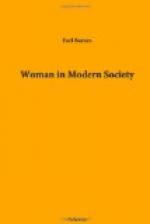But the great element of uncertainty, always fronting the girl and young woman, is marriage. Marriage for her generally means abandonment of old working interests, and a substitution of new; it brings her geographical change; new acquaintances and friendships; and the steady adjustment of her personal life to the man she has married in its relation to industry, religion, society and the arts. If children come to her, they must inevitably retire her from public life, for a time, with the danger of losing connections which comes to all who temporarily drop out of the race.
A boy, industrious, observant, with some power of administration, studies mining engineering, moves to a mining center and expresses his individual and social powers along the lines of his work until he is sixty. The women who impinge against his life may deflect him from the mines in California to those in Australia, or from the actual work of superintendence to an office; or from an interest in Browning to Tennyson; or from Methodism to Christian Science. The girl with industrious and observant interests studies stenography and type-writing, moves to the vicinity of offices, but is then caught up in the life of a farmer-husband who shifts her center of activity to a farm in Idaho where she must devote herself to entirely different activities, form new associations, think in new terms, respond to new emotions, and adjust herself to her farmer-husband’s personality. When, after twenty-five years, she has reared a family of children, and when improved circumstances enable them to move up to the county seat, she confronts many of the conditions for which she originally prepared herself, but with farm habits, diminishing adaptability and diminishing power of appealing to her husband. His powers are still comparatively unimpaired, and as a dealer in farm produce or farm machinery his interests undergo slight change. In general, it may be said that a woman’s life falls into three great periods of twenty-five years each. The first twenty-five years of childhood and girlhood is a time of getting ready for the puzzling combination of her personal needs as a human being, her needs as a self-supporting social unit, and her probabilities of matrimony. The second twenty-five years, the domestic period of her life, is a time of adjustments as wife and mother, which may instead prove to be a period of barren waiting, or a time of professional and industrial self-direction and self-support. The third twenty-five years is a time of mature and ripened powers, of lessened romantic interests, and if the preceding period has been devoted to husband and children, it is often a time of social detachment, of weakened individual initiative, of old-fashioned knowledge, of inefficiency, of premature retirement and old age.




